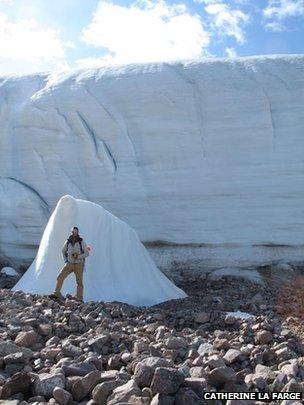Centuries-old frozen plants revived
- Published

Glacier retreat has markedly accelerated in the period since 2004 - and many new species lie beneath
Plants that were frozen during the "Little Ice Age" centuries ago have been observed sprouting new growth, scientists say.
Samples of 400-year-old plants known as bryophytes have flourished under laboratory conditions.
Researchers say this back-from-the-dead trick has implications for how ecosystems recover from the planet's cyclic long periods of ice coverage.
The findings appear in Proceedings of the National Academy of Sciences, external.
They come from a group from the University of Alberta, who were exploring an area around the Teardrop Glacier, high in the Canadian Arctic.
The glaciers in the region have been receding at rates that have sharply accelerated since 2004, at about 3-4m per year.
That is exposing land that has not seen light of day since the so-called Little Ice Age, a widespread climatic cooling that ran roughly from AD 1550 to AD 1850.
"We ended up walking along the edge of the glacier margin and we saw these huge populations coming out from underneath the glacier that seemed to have a greenish tint," said Catherine La Farge, lead author of the study.
Bryophytes are different from the land plants that we know best, in that they do not have vascular tissue that helps pump fluids around different parts of the organism.
They can survive being completely desiccated in long Arctic winters, returning to growth in warmer times, but Dr La Farge was surprised by an emergence of bryophytes that had been buried under ice for so long.
"When we looked at them in detail and brought them to the lab, I could see some of the stems actually had new growth of green lateral branches, and that said to me that these guys are regenerating in the field, and that blew my mind," she told BBC News.
"If you think of ice sheets covering the landscape, we've always thought that plants have to come in from refugia around the margins of an ice system, never considering land plants as coming out from underneath a glacier."
But the retreating ice at Sverdrup Pass, where the Teardrop Glacier is located, is uncovering an array of life, including cyanobacteria and green terrestrial algae. Many of the species spotted there are entirely new to science.
"It's a whole world of what's coming out from underneath the glaciers that really needs to be studied," Dr La Farge said.
"The glaciers are disappearing pretty fast - they're going to expose all this terrestrial vegetation, and that's going to have a big impact."
- Published7 March 2013